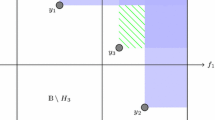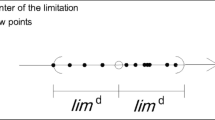Abstract
Many problems in engineering design involve the use of nonlinearities and some integer variables. Methods based on test sets have been proposed to solve some particular problems with integer variables, but they have not been frequently applied because of computation costs. The walk-back procedure based on a test set gives an exact method to obtain an optimal point of an integer programming problem with linear and nonlinear constraints, but the calculation of this test set and the identification of an optimal solution using the test set directions are usually computationally intensive. In problems for which obtaining the test set is reasonably fast, we show how the effectiveness can still be substantially improved. This methodology is presented in its full generality and illustrated on two specific problems: (1) minimizing cost in the problem of scheduling jobs on parallel machines given restrictions on demands and capacity, and (2) minimizing cost in the series parallel redundancy allocation problem, given a target reliability. Our computational results are promising and suggest the applicability of this approach to deal with other problems with similar characteristics or to combine it with mainstream solvers to certify optimality.



Similar content being viewed by others
References
4ti2 team. 4ti2—a software package for algebraic, geometric and combinatorial problems on linear spaces. www.4ti2.de
Achterberg, T.: SCIP: solving constraint integer programs. Math. Program. Comput. 1(1), 1–41 (2009)
Ahmadizar, F., Soltanpanah, H.: Reliability optimization of a series system with multiple-choice and budget constraints using an efficient ant colony approach. Expert Syst. Appl. 38(4), 3640–3646 (2011)
Ahmed, S., Shapiro, A.: Solving chance-constrained stochastic programs via sampling and integer programming. www2.isye.gatech.edu/people/faculty/Shabbir-Ahmed/cctutorial. Accessed 30 April 2014
Avis, D., Fukuda, K.: Reverse search for enumeration. Discret. Appl. Math. 65(1–3), 21–46 (1996)
Belotti, P. Couenne. www.coin-or.org/Couenne/
Bonami, P., contributors.: Bonmin—basic open-source nonlinear mixed integer programming. https://projects.coin-or.org/Bonmin
Cbc (Coin-or branch and cut). https://projects.coin-or.org/Cbc
Castro, F., Gago, J., Hartillo, I., Puerto, J., Ucha, J.M.: An algebraic approach to integer portfolio problems. Eur. J. Oper. Res. 210(3), 647–659 (2011)
Chern, M.S.: On the computational-complexity of reliability redundancy allocation in a series system. Oper. Res. Lett. 11(5), 309–315 (1992)
Coit, D.W., Smith, A.E., Tate, D.M.: Adaptive penalty methods for genetic optimization of constrained combinatorial problems. INFORMS J. Comput. 8(2), 173–182 (1996)
Coit, D.W., Smith, A.E.: Reliability optimization of series-parallel systems using a genetic algorithm. IEEE Trans. Reliab. 45(2), 254–260 (1996)
Gurobi Optimization, Inc.: Gurobi optimizer reference manual. http://www.gurobi.com
Czyzyk, J., Mesnier, M.P., Moré, J.J.: The NEOS server. IEEE Comput. Sci. Eng. 5(3), 68–75 (1998)
Djerdjour, M., Rekab, K.: A branch and bound algorithm for designing reliable systems at a minimum cost. Appl. Math. Comput. 118(2–3), 247–259 (2001)
Dolan, E.: The NEOS server 4.0 administrative guide. Technical report technical memorandum ANL/MCS-TM-250, Mathematics and Computer Science Division, Argonne National Laboratory, (2001)
Gago, J., Hartillo, I., Puerto, J., Ucha, J.M.: Exact cost minimization of a series-parallel system. Comput. Oper. Res. 40(11), 2752–2759 (2013)
Gropp, W., Moré, J.J.: Optimization Environments and the NEOS Server. Approximation theory and optimization. Cambridge University Press, Cambridge (1996)
Hemmecke, R., Schultz, R.: Decomposition of test sets in stochastic integer programming. Math. Program. 94(2–3), 323–341 (2003)
Li, D., Sun, X.: Nonlinear Integer Programming. Springer, New York (2006)
Luedtke, J., Ahmed, S., Nemhauser, G.: An Integer Programming Approach for Linear Programs with Probabilistic Constraints. Lecture notes in computer science 4513. Springer, Berlin (2007)
MOSEK ApS, Fruebjergvej 3, Boks 16, 2100 Copenhagen O, Denmark. The MOSEK optimization tools manual version 6.0, 2009. http://www.mosek.com/
Ouzineb, M., Nourelfath, M., Gendreau, M.: Tabu search for the redundancy allocation problem of homogenous series-parallel multi-state systems. Reliab. Eng. Syst. Saf. 93(8), 1257–1272 (2008)
Ruan, N., Sun, X.: An exact algorithm for cost minimization in series reliability systems with multiple component choices. Appl. Math. Comput. 181(1), 732–741 (2006)
Ruszczyński, A.: Probabilistic programming with discrete distributions and precedence constrained knapsack polyhedra. Math. Program. 93(2), 195–215 (2002)
Schlueter, M., Gerdts, M.: The oracle penalty method. J. Global Optim. 47(2), 293–325 (2010)
Sturmfels, B.: Gröbner Bases and Convex Polytopes, vol. 8. American Mathematical Society, Providence (1996)
Tawarmalani, M., Sahinidis, N.V.: A polyhedral branch-and-cut approach to global optimization. Math. Program. 103(2), 225–249 (2005)
Tayur, S.R., Thomas, R.R., Natraj, N.R.: An algebraic-geometry algorithm for scheduling in presence of setups and correlated demands. Math. Program. 69(3), 369–401 (1995)
Acknowledgments
This paper has been partially supported by Junta de Andalucía under Grant FQM-5849, and Ministerio de Ciencia e Innovación MTM2010-19336, MTM2010-19576, MTM2013-46962-C2-1-P and FEDER. The authors would like to thank the anonymous reviewers for their valuable comments and suggestions to improve the quality of the paper.
Author information
Authors and Affiliations
Corresponding author
Appendix: A Proof of Theorem 3
Appendix: A Proof of Theorem 3
Let \(A\) be the matrix associated with the restrictions for Problem (LSP-II). Then \(A\) can be divided in five blocks according to the five sets of variables \(y_{ij}, a_{ij}, z_{ij}, b_{ij}\) and \(c_{ij}\). Let \(I\) denote the identity matrix of size \(mn\) and \(\varvec{O}\) denote a matrix with all entries zero. Let \(D\) be the block diagonal \((0,1)\)-coefficient matrix associated with constraints (7). Let \(-MI\) denote the coefficient matrix of the variables \(z_{ij}, i=1,\ldots ,n, j=1,\ldots ,m\) in constraints (8). We can then write \(A\) as the \((n+3mn) \times 5mn\) integer matrix
We note \(t = (t_y, t_a, t_z, t_b, t_c), S = \{ t ~|~ A t = 0 \}\) and the block \(t_y\) represents the variables \((Y_{11}, \ldots , Y_{mn})\), noted in capital letters. Similar for the other blocks. Consider the following cases:
-
1.
\(K_1 = \{ t \in S ~|~ t_y = t_b = 0 \}\). Let \(S' = \ker A'\), where
$$\begin{aligned} A' = \left( \begin{array}{ccc} I &{} -MI &{} \varvec{O} \\ \varvec{O} &{} I &{} \varvec{O} \\ \varvec{O} &{} I &{} I \end{array} \right) \rightarrow \left( \begin{array}{ccc} I &{} -MI &{} \varvec{O} \\ \varvec{O} &{} I &{} \varvec{O} \\ \varvec{O} &{} \varvec{O} &{} I \end{array} \right) \!\!, \end{aligned}$$which is not singular. Then \(K_1 = 0\) and there is no binomial \(x^\alpha - x^\beta \) such that contains only the variables \(a_{ij}, z_{ij}, c_{ij}\).
-
2.
\(K_2 = \{ t \in S ~|~ t_b = 0 \}\). Let \(S''= \ker A''\), where
$$\begin{aligned} A'' = \left( \begin{array}{cccc} D &{} \varvec{O} &{} \varvec{O} &{} \varvec{O} \\ I &{} I &{} -MI &{} \varvec{O} \\ \varvec{O} &{} \varvec{O} &{} I &{} \varvec{O} \\ -I &{} \varvec{O} &{} I &{} I \end{array} \right) . \end{aligned}$$By the previous case, we can assume \(t_y \ne 0\). The rows in the third block imply that \(t_z = 0\). Then \(t \in K_2\) if and only if \((t_y,t_a,t_c) \in S''' = \ker A'''\), for
$$\begin{aligned} A''' = \left( \begin{array}{ccc} D &{} \varvec{O} &{} \varvec{O} \\ I &{} I &{} \varvec{O} \\ -I &{} \varvec{O} &{} I \end{array} \right) . \end{aligned}$$Let \(Y_{ip}\) be the leftmost nonzero component in \(t_y\). We can assume \(Y_{ip} > 0\), because \(S'''\) is a vector space. The row block corresponding to \(D\) implies that there exists \(q > p\) such that \(Y_{iq} < 0\). Then
$$\begin{aligned} y_{ip} \text { divides } x^{t^+}, y_{iq} \text { divides } x^{t^-}. \end{aligned}$$The second block of rows in \(A'''\) implies \(A_{ip} = - Y_{ip} < 0, A_{iq} = -Y_{iq} > 0\). From the third block of rows, \(C_{ip} = Y_{ip} > 0, C_{iq} = A_{iq} < 0\). Then
$$\begin{aligned} y_{ip} a_{iq} c_{ip} \text { divides } x^{t^+}, y_{iq} a_{ip} c_{iq} \text { divides } x^{t^-}. \end{aligned}$$The initial term in \(x^{t^+} - x^{t^-}\) with respect to \(>\) is \(x^{t^+}\) because \(y_{ip}\) divides \(x^{t^+}\) and \(y_{ip}\) it the greatest monomial in the binomial. Then the initial term of
$$\begin{aligned} y_{ip} a_{iq} c_{ip} - y_{iq} a_{ip} c_{iq} \end{aligned}$$(12)divides the initial term of \(x^{t^+} - x^{t^-}\).
-
3.
Let \(S = \ker A\). By (a) and (b) we suppose \(t_b \ne 0\). Let \(B_{rs}\) the leftmost nonzero component in \(t_b\). As in the previous case, take \(B_{rs} > 0\). Because \(b\) is the set of greatest variables for our term order, \(x^{t^+}\) is the leading term. We also have \(Z_{rs} = -B_{rs} < 0\).
-
(a)
If \(Y_{rs} \ge 0\) then
$$\begin{aligned} -Y_{rs} + Z_{rs} + C_{rs} = 0 \end{aligned}$$then
$$\begin{aligned} b_{rs}c_{rs} \text { divides } x^{t^+} \end{aligned}$$and the initial term of
$$\begin{aligned} b_{rs} c_{rs} - z_{rs} a_{rs}^{M_r}. \end{aligned}$$(13)divides \(x^{t^+}\).
-
(b)
\(Y_{rs} < 0\). Then there exists \(Y_{rq}, \,s\ne q\) with \(Y_{rq}=-Y_{rs}>0\) .
-
i.
If \(C_{rq} > 0\), then \(b_{rs}y_{rq}c_{rq}\) divides \(x^{t^+}\). The initial term of
$$\begin{aligned} b_{rs} y_{rq} c_{rq} - z_{rs} y_{rs} a_{rs}^{M_r-1} a_{rq}, s \ne q. \end{aligned}$$(14)divides the initial term of \(x^{t^+}-x^{t^-}\).
-
ii.
If \(C_{rq}\le 0\) then \(0<Y_{rq}\le Z_{rq}\), which implies \(B_{rq}<0\) so \(s < q\), because \(B_{rs}\) was the first nonzero element. The rows in the second block imply that
$$\begin{aligned}&Y_{rq} + A_{rq} - M_r Z_{rq} = 0, \text { so } A_{rq} = M_r Z_{rq} - Y_{rq} \ge M_r Y_{rq} - Y_{rq} \\&\quad = (M_r -1) Y_{rq}. \end{aligned}$$Then the initial term of
$$\begin{aligned} b_{rs} y_{rq} z_{rq} a_{rq}^{M_r-1} - z_{rs} y_{rs} b_{rq} a_{rs}^{M_r-1}, s < q \end{aligned}$$(15)divides the initial term of \(x^{t^+}-x^{t^-}\).
-
i.
-
(a)
We have reviewed all the cases, so the sets (12), (13), (14) and (15) form the reduced Gröbner basis.
Rights and permissions
About this article
Cite this article
Gago-Vargas, J., Hartillo, I., Puerto, J. et al. An improved test set approach to nonlinear integer problems with applications to engineering design. Comput Optim Appl 62, 565–588 (2015). https://doi.org/10.1007/s10589-015-9739-3
Received:
Published:
Issue Date:
DOI: https://doi.org/10.1007/s10589-015-9739-3




